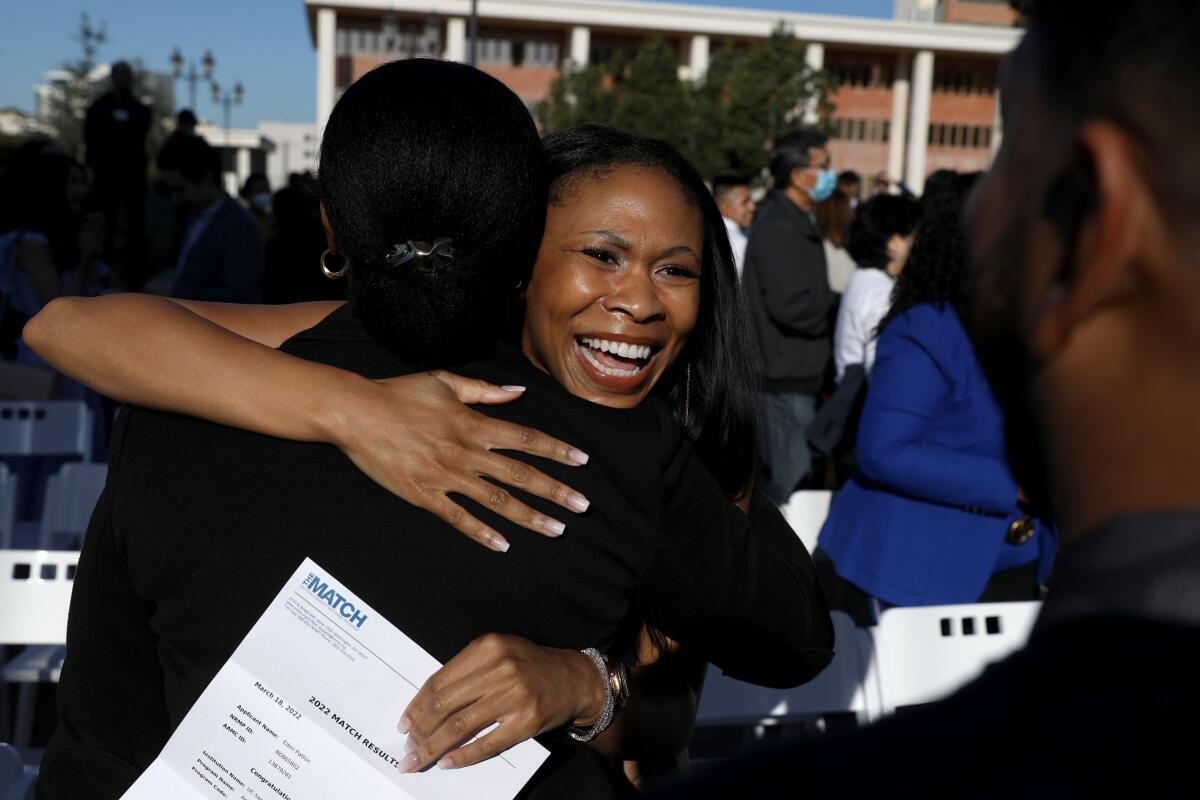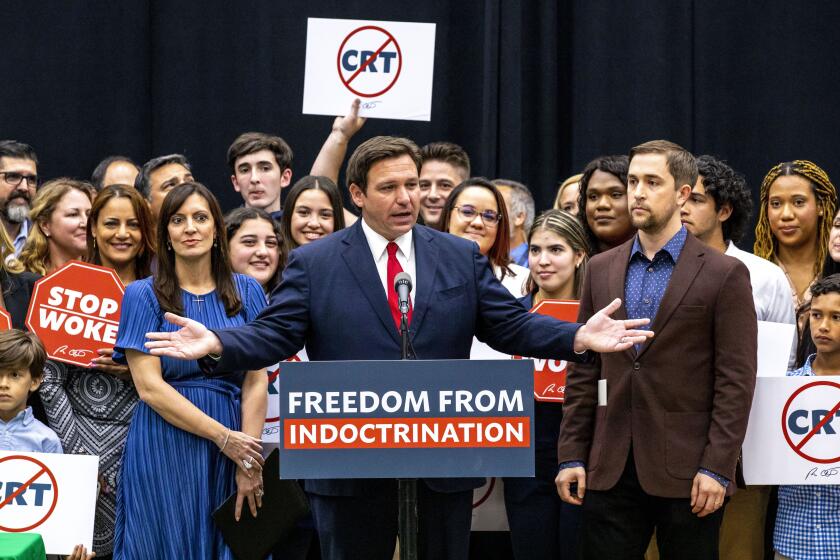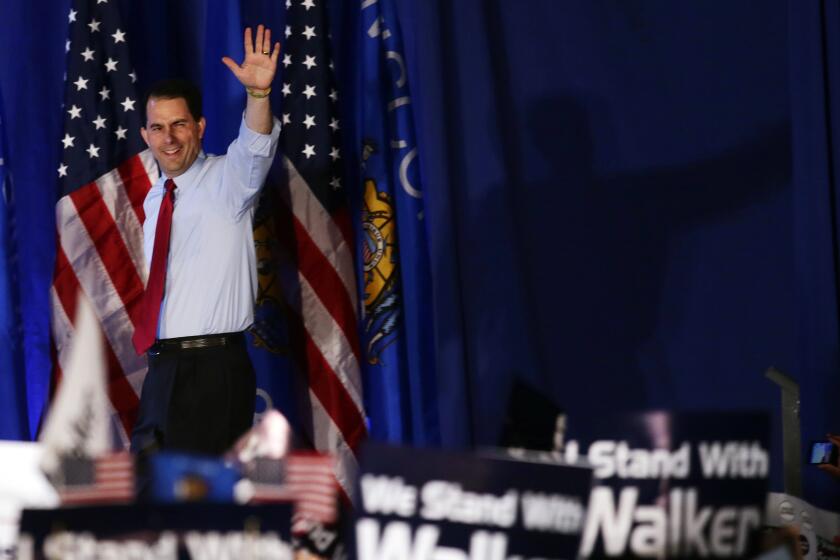Column: Is UCLA a ‘failed medical school’? Debunking a dumb right-wing meme

The right-wing and Republican project to eradicate diversity and inclusiveness from American society has become more absurd with every passing day, but it will be hard for anyone to produce a more vapid and fatuous effort than a recent article labeling UCLA’s David Geffen School of Medicine as a “failed medical school.”
The reason for that label, according to the right-wing Washington Free Beacon, which published the article, is that UCLA has “prioritized diversity over merit, resulting in progressively less qualified classes that are now struggling to succeed.”
To its perverse credit, the Beacon doesn’t conceal the racist import of its claims; on the contrary, it announces it outright, citing the school’s “race-based admissions” and quoting one of its anonymous sources (there is no other category) as saying, “We want diversity so badly, we’re willing to cut corners to get it.”
An admissions officer is quoted anonymously as grousing, “All the normal criteria for getting into medical school only apply to people of certain races. For other people, those criteria are completely disregarded.”
We’re not backing off from diversity, equity and inclusion in our medical school curricula. It’s really intended to train the next generation of physicians to respond appropriately to a rapid growth in diversity.
— Steven Dubinett, dean, UCLA School of Medicine
The article purports to rely on complaints from eight of the school’s faculty members. The medical school’s full-time faculty numbers more than 2,000, with an additional 2,000 to 2,500 part-timers or adjuncts. That should give you a clue to how deeply the Beacon delved into the facts before issuing its eye-catching conclusion.
Get the latest from Michael Hiltzik
Commentary on economics and more from a Pulitzer Prize winner.
You may occasionally receive promotional content from the Los Angeles Times.
But that’s only one aspect of a piece that trips over its supposed “facts” at almost every turn, openly cherry-picks data to confirm its biases, and treats every factoid as an artifact of the quest for diversity. Its author doesn’t even appear to understand the distinction between the student admissions process and the entirely separate process of appointing residents, who are medical school graduates, many if not most of whom received their medical education elsewhere.
“I consider it to be fact-free,” Steven M. Dubinett, the school’s dean, told me about the Beacon article. He’s being kind.
Before delving into the article itself, a few words abut the Washington Free Beacon. The Beacon was founded in 2012 with funding from, among other conservatives, hedge fund billionaire Paul Singer. Its first editor was co-founder Matthew Continetti, who is a son-in-law of conservative pundit Bill Kristol.
Did Claudine Gay resign from Harvard because of plagiarism or her bad answer about antisemitism? Neither — it was the outcome of a right-wing attack on higher education nationwide.
The Beacon’s driving impulse appears to be “owning the libs,” as shown by its preening over its role in advancing the criticism of former Harvard President Claudine Gay for what many in the academic community regard as trivial cases of plagiarism.
That scandal-mongering was basically the handiwork of right-wing attack dog Christopher Rufo, who carried the theme further by accusing other Harvard figures of plagiarism; curiously, as the Harvard Crimson notes, they were all Black women, like Gay.
The Beacon’s tone was described as “puckish” by a Washington Post writer who apparently doesn’t know what “puckish” means; he praised it in the same article as standing a hair above other right-wing websites, which strikes me as a bit like trying to identify the best “Sharknado” movie. The basis of his praise was that the Beacon “does significant reporting of its own.” But if “significant” means “cogent,” that quality isn’t much in evidence in the article about UCLA.
So let’s pick up our endoscopes and take a look inside.
The main target of the article is Jennifer Lucero, who became associate dean for admissions in June 2020. The article posits that her arrival in that post, and her focus on diversity, led to a precipitous drop in the quality of incoming students. More on that in a moment.
The article’s empirical assertions, such as they are, start with the annual medical school rankings of U.S. News and World Report. These have been controversial for years, in part because their methodology is suspect. As a result, many of the top-ranked schools have stopped cooperating with them, though the University of California still participates.
The article’s author, Aaron Sibarium, wrings his hands over the fact that UCLA’s ranking in “research” has fallen to 18th from sixth place in just the first three years after Lucero’s arrival.
Couple of problems there. One is that research ranking tracks the activities of faculty members, not students. It has nothing to do with the record of the incoming class. Dubinett says that one reason UCLA may have fallen in the rankings is that it has assigned more faculty to clinical education than to research, so the grant level per faculty has naturally declined.
Robert F. Kennedy is getting a lot of press because of his name, but it’s his anti-vaccine claims that need to be scrutinized.
But that’s not the only measure of research quality. Consider the grant approvals by the National Institutes of Health, the nation’s leading source of public grants in medicine. UC as a whole has consistently been a top recipient of NIH grants — ranking first in the nation since at least 2000 and probably for much longer than that. For most of that period, UCLA has been the second-largest recipient among UC campuses behind the research powerhouse of UC San Francisco.
From 2010 through 2019 and again in 2022 UCLA fell to third behind UCSF and narrowly behind UC San Diego, but for three of the four years of Lucero’s tenure it’s been second. There’s no sign there of a decline in research stature.
Sibarium, who did not respond to a request for comment, deserves an F in that category but an A for cherry-picking. On the other metric that U.S. News uses consistently, primary care, UCLA has risen in rank since 2020, to 10th in the nation from 11th. And in other categories, the school’s ranking has risen since 2020 — for example to seventh from 10th in internal medicine and sixth from 12th in pediatrics.
Sibarium’s other “gotcha” concerns the UCLA students’ records on shelf exams, which are given after each clinical rotation. He asserts that their failure rates have risen precipitously during the Lucero era: “As the demographics of UCLA have changed,” he writes, “the number of students failing their shelf exams has soared.” He quotes a professor, anonymously, saying, “Faculty are seeing a shocking decline in knowledge of medical students.”
But as he acknowledges, UCLA dramatically changed its academic schedule in 2020. Along with many other top schools, it moved students out of the classroom in the second of their four years of education, instead of waiting for the third. That deprived students of a full year of clinical training before they took the shelf, so of course they did worse. But the official chart illustrating Sibarium’s article shows that the failure rate on most clinical specialties has fallen as the students progressed from Year 2 to Year 3.
“The challenge of moving the exams earlier has been written about,” Dubinett says. But the trend lines show that by the end of their third year, the average shelf exam grade in almost every clinical discipline is well north of 90%.
Attacks on university tenure and academic freedom in Texas, Florida, Tennessee and North Carolina will make those states less competitive.
The Beacon’s brief against Lucero is tied to its evident resentment of diversity programs. Sibarium points to a required first-year course titled “Structural Racism and Health Equity,” which comprises “three to four hours every other week,” as though a twice-monthly course is supposed to be an unsupportable burden to medical students.
Is there a point to that sort of training? Of course there is: “We’re cognizant that more than 80% of health is based on social determinants,” Dubinett says, pointing out that the phenomenon was very much on display in racial and ethnic disparities in treatment and outcomes during the COVID-19 pandemic.
“These inequities result, in large part, from racial and ethnic minority populations’ inequitable access to healthcare, which persists because of structural racism in healthcare policy,” according to a 2022 paper in Health Affairs.
“We’re not backing off from diversity, equity and inclusion in our medical school curricula,” Dubinett says. “It’s really intended to train the next generation of physicians to respond appropriately to a rapid growth in diversity.” In few other places are the effects of inattention to social conditions more evident than in Los Angeles, he says. “We can look no further than what’s outside our front door — if I drive 15 minutes to the south from my office, life expectancy falls by 15 years.”
The Beacon even states that diversity efforts at UCLA may be illegal or unconstitutional, since the state’s voters outlawed racial preferences at public institutions in 1996 and the U.S. Supreme Court overturned them nationwide last year.
To support this absurd claim, Sibarium turns to Adam Mortara, the lawyer who represented the plaintiffs in the Supreme Court case. Asking for information about an applicant’s race when “no lawful use can be made of it” is “presumptively illegal,” Mortara said. The lawyer added, almost beseechingly, “You can’t have evidence of overt discrimination like this and not have someone come forward” as a plaintiff.
The problem with the claim is that there’s no evidence that the medical school has applied racial or ethnic standards to its applicants. Sibarium admits as much: The application committee “for students does not see the race or ethnicity of applicants,” he writes. So where’s the beef?
Sibarium insinuates that Lucero has exercised undue influence over residency acceptances. But he finds that she’s a member of the hiring committee only for anesthesia residents (anesthesia is Lucero’s medical specialty). Couple of issues here. One is that almost no one gets hired for a medical residency anywhere without an interview, either in person or by Zoom, which is designed to give the committee a holistic sense of the applicants’ character and personality, not just their test scores.
Florida Surgeon Gen. Dr. Joseph A. Ladapo is advising people to avoid the most effective COVID vaccines, just as a surge in disease cases gets worse.
Another is that by the author’s own admission, Lucero hasn’t been especially effective in instituting diversity tests for anesthesia residents. He cites one case in which she advocated that a white candidate be ranked downward and another in which she “insisted that a Hispanic applicant who had performed poorly on her anesthesiology rotation in medical school should be bumped up.” As it happened, he reports, “neither candidate was ultimately moved.”
(As for a case Sibarium mentions in which Lucero supposedly pushed to admit a Black student whose grades and test scores were below the UCLA average, he doesn’t say whether the student was admitted.)
It’s true that the entering medical school class at UCLA has become more diverse over time. Figures issued by UCLA and published by the Beacon show that from 2019 through 2022, the number of whites in the 173-member class declined to 46 from 49, the number of Black students rose to 25 from 22, Hispanic students rose from 25 to 37, a catchall “other” category grew to 20 from eight, and American Indians, Hawaiians and other Pacific Islanders went from zero to three. The number of Asian students declined to 55 from 84.
Does this validate the article’s assertion, voiced by an anonymous source (of course), that “a third to a half of the medical school is incredibly unqualified”?
The math doesn’t pencil out. As blogger and statistics maven Kevin Drum notes, given that the number of nonwhite and non-Asian students increased by only 30 in three years, even if “every single one of these students was woefully unqualified, that’s about 17% of the class. How do you get from there to ‘a third to a half’?”
By the way, the median grade-point averages and scores on the Medical College Admission Test of accepted applicants haven’t declined at all since 2020 — the MCAT average in 2023 was the same as in 2020, and the GPA rose by a hair.
In emails to the medical school class, Dubinett and his fellow deans have reinforced their commitment to merit-based admissions and diversity training. “Students and faculty members are held to the highest standards of academic excellence,” they wrote. “Highly qualified medical students and trainees are admitted ... based on merit in a process consistent with state and federal law.” That said, “we are enriched by the diverse experiences each of you brings to our community.”
UCLA, then, is standing firm against the right wing’s drive to pretend that racial and ethnic discrimination doesn’t exist in our society and to undermine efforts to wipe it out. Would that more institutions took that stand, instead of capitulating to a dishonest, braying mob.
More to Read
Inside the business of entertainment
The Wide Shot brings you news, analysis and insights on everything from streaming wars to production — and what it all means for the future.
You may occasionally receive promotional content from the Los Angeles Times.















